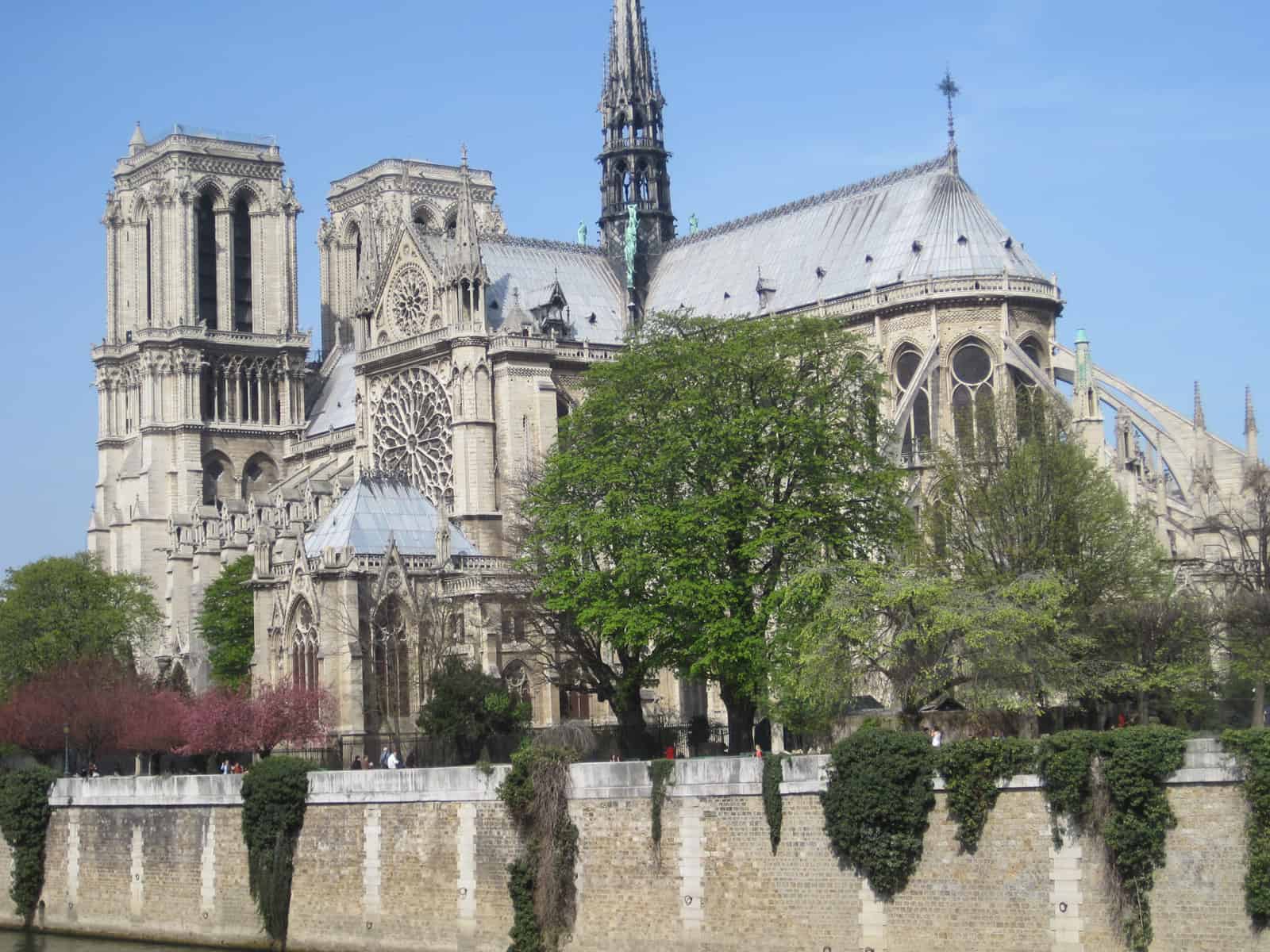Stroll 1: Île de La Cité
Quick Description: Birthplace of the city, major sites from the Romans to the Revolution.
Where: Island at city’s center, plus sites nearby on the Left Bank. Note: This stroll covers the eastern two thirds of the island, including Cathedral Notre Dame, Le Conciergerie and the Sainte-Chapelle. The western end of the island, with the Pont Neuf, Square du Vert Galant and Place Dauphine is covered in Stroll 3.
Start and End at Place Saint Michel, outside Metro station Saint Michel – Notre Dame (#4 line).
Duration: 1 hr walk, @2.5-4 hrs with all venue visits; add 1 hr for Notre Dame Towers. Early Departure Option.
Best Days: Tues – Sat.
Best Start Time: 9am – Noon.
Ready to stroll?
Open this page vertically on your mobile phone and click VIEW DIRECTIONS.
Connects: by foot to Stroll 2 (The Latin Quarter), or Stroll 3 (Quarter of the Mint) (which also covers the western end of Ile de la Cite), and by a quick Metro rides to Stroll 11 (Saint Germain – East), or Stroll 12 (Saint Germain – West), or Stroll 30 (Montparnasse).
Past and Present: Île de La Cité is the 2300-year-old historic center of Paris and France. It began as an island trading post of the Parisii tribe in about 300 BC. In 52 BC, the Roman army conquered the Parisii and soon established the town of Lutetia on the island and the adjacent Left Bank. The town was renamed Paris in 360. In the mid-400s, the Romans were ousted from France (Gaul) by a Germanic tribe called the Franks, who made Paris their capital. The Franks defended the town against Viking invaders in the 800s and built a palace on the island in the 900s. Paris then began expanding on both banks of the river, yet as late as the 19th century the island remained its most densely populated area. That changed during the Second Empire (1851-1870), when many medieval buildings and streets were demolished as part of a general overhaul and beautification of the city. Additional clearing took place at the center of the island in the 1960s. That later work revealed a network of ancient buried streets that became an archeological crypt exhibit, open to the public. It turns out that the island’s ground level now is four or five stores higher than in Roman times due to building atop earlier levels. Today, few people live on Ile de la Cite, and the major businesses are public institutions, including the Palais de Justice court complex and the Hotel Dieu hospital. The real function of the island is to be a showplace for its historic venues, such the crypt, the Sainte-Chapelle with its incomparable stained glass, the Conciergerie palace/prison and, of course, the great Cathedral Notre Dame, which was damaged by fire in 2019 but is being repaired. All help to tell the long and fascinating saga of the city and nation that began here.
Attractions (in order):
- Place / Fontaine / Boulevard Saint Michel: 19th century intersection with pedestrian plaza featuring a dramatic, large carved fountain that is one of the city’s iconic symbols.
- Rue de la Huchette: On the Left Bank, running from Blvd Saint Michel to Rue Saint Jacques. This very old street is now part of the Latin Quarter’s pedestrian zone and is lined with colorful food shops, restaurants. and entertainment venues.
- Petit Pont: Bridge from the Left Bank to the island, arriving at one end of the large plaza (parvis) in front of Cathedral Notre Dame. A bridge has been at this location since Roman times.
- Crypte Archeologique de l’Ile de la Cite: #7 Parvis de Notre Dame – Place Jean Paul II. Underground archeological exhibit showing the buildup of the island (ground level is several stories higher than in ancient times) including the footprints of ancient streets. Tues-Sun, 10am-6pm, €9, under 18 free.
- Charlemagne Statue: Parvis de Notre Dame – Place Jean Paul II. Statue celebrating perhaps the greatest monarch of the Middle Ages, who ruled over much of what is now Western Europe and became the first Holy Roman Emperor in 800.
- Cathedral Notre Dame de Paris: Parvis de Notre Dame – Place Jean Paul II. World famous Gothic cathedral that was constructed from the 1100s to the 1300s, featuring a spectacular exterior and interior, plus towers overlooking the city. The cathedral was seriously damaged by fire in April, 2019, but is scheduled to reopen in 2024. Previous hours were: Interior open daily 8am-6:45pm (7:15pm Sat-Sun) free; Towers open daily 10am-5:30pm, €10E (400 stairs, no elevator). Masses at which the Crown of Thorns is presented and venerated were given at 3pm on the first Friday of the month and on all Fridays during Lent. Good Friday Mass lasted 10am to 5pm.
- Square Jean XXIII: Public park at rear of Cathedral Notre Dame. Created in 1844, this park was renamed in the 20th century for Pope John XXIII. It features a variety of trees, as well as sculptures and benches for relaxing. Due to the reconstruction work at Cathedral Notre Dame, this park is closed until 2024. Previously it was open from dawn to dusk.
- Square de l’Ile de France: Public park at the eastern tip of the island. Created in 1914 on landfill built up over the centuries, the park offers great views and the Memorial des Martyrs de la Deportation. Park open Mon-Fri 8am-8:30pm, Sat-Sun 9am-8:30pm, free.
- Memorial des Martyrs de la Deportation: Inside Square de l’Ile de France park, behind the cathedral at the island’s eastern tip. Indoor Holocaust memorial, dedicated to the people of France who were deported to the Nazi concentration camps during WWII. Tues-Sun, 10am-7pm, free.
- Pont Saint Louis: Bridge behind the cathedral at the island’s eastern tip. This 1970 bridge is the eighth here since 1630 connecting Ile de la Cite to Ile Saint Louis. It is frequently a stage for street performers.
- Ancien Cloitre Quartier: Neighborhood of atmospheric medieval streets adjacent to the cathedral. For hundreds of years this was a closed-off domain of the archdiocese of Paris, occupied by clergy and church workers. Streets of particular interest here include Rue des Chantres, one of the narrowest streets in Paris, Rue des Ursins, site of the Quartier’s medieval wharf, and Rue de la Colombe, featuring Roman and medieval artifacts.
- Maison Heloise et Abelard: #9-11 Quai Aux Fleurs, in the Ancien Cloitre Quartier. Residential building with façade carvings that pay homage to the legendary star-crossed lovers of the early 12th century whose drama played out right here.
- Point Kilometre Zero: Parvis de Notre Dame – Place Jean Paul II. Marker embedded in the ground indicating the exact center of the city, and used for measuring national highway distances.
- Hotel-Dieu courtyard garden: In the Hotel-Dieu hospital, #1 Parvis de Notre Dame – Place Jean Paul II. Accessible daily, free.
- Place Louis Lepin Flower Market and Bird Market: Just west of the Hotel Dieu, second half of route. The Flower Market (Marche Aux Fleurs) consists of greenhouse structures with various businesses selling cut flowers, plants, garden equipment, home décor, holiday decorations and, souvenirs. Most are open Mon-Sat 8am-7:30pm. The outdoor bird market (Marche des Oiseaux) is held here on Sundays.
- Palais de Justice: Entry at #10 Blvd du Palais, adjacent to Sainte-Chapelle. Elegant complex of courts and judicial offices constructed during the Second Empire in the mid-19th century. View through the gate, not usually open to tourists.
- Pont Au Change: At Blvd du Palais and Quai de Harley. This bridge connecting the island to the Right Bank dates from the early 1800s, but the first bridge here was built in the 1100s and housed the shops of money changers, hence its name.
- Tour de l’Horlogue: Corner of Blvd du Palais and Quai de Harley, near the Pont Au Change. Clock Tower of Le Conciergerie, the city’s first public clock, dating from 1370.
- Le Conciergerie: Entry at #2 Boulevard du Palais. Medieval royal palace and Revolution-era prison. Visitors have access to the great halls of the original Palais de la Cite and the areas where prisoners were held while awaiting their execution on the Revolution’s guillotine. Included are re-creations of Queen Marie Antoinette’s bedroom and chapel cells. Daily 9:30am-6pm, €11.5, free for EU citizens under 26. Combination ticket with Sainte-Chapelle €18.5.
- Sainte-Chapelle: Entry at #10 Boulevard du Palais. 13th century royal chapel on two levels, with world-renowned stained-glass windows. Daily, 9am-5pm (to 7pm 4/1 – 9/30), €11.5, free to EU citizens 18-25, persons under 18 with family group, and handicapped persons. Combination ticket with Le Conciergeire €18.5
- Pont Saint Michel: Bridge roadway connecting Ile de la Cite to the Left Bank. The third bridge at this location since 1378, in 1961 it was the scene of a notorious massacre of Algerian protesters by France’s National Police, and a plaque affixed to the bridge memorializes the incident.
Dining Suggestions (in order):
- Au Bognat: #26 Rue Chanoinesse, at Rue de la Colombe, in the Ancien Cloitre Quartier near Cathedral Notre Dame. French cuisine. Traditional room. Mon-Sat Noon-10pm. Average cost @€35-45 3 courses.
- Aux Vieux Paris d’Arcole: #24 Rue Chanoinesse, just south of Rue de la Colombe, in the Ancien Cloitre Quartier, near Cathedral Notre Dame. French cuisine. Dining room with 18th century décor, a couple of outdoor tables. Sun-Fri Noon-3pm, 6-11pm, Sat 6-11pm. Prix fix 2 course lunch @€20, a la carte 2 courses @€40.
- Brasserie Les Deux Palais: #3 Blvd du Palais, opposite Saint-Chapelle and the Palais de Justice. French cuisine, plus salads, bowls. Elegant Belle Epoque décor, outdoor seating. Mon-Sat 7am-10pm, Sun 8am-10pm. Appetizers @€8-22, Mains @€18-22.
- Le Zimmer: #1 Place du Chatelet, on the Right Bank near Pont Au Change (a 5-minute walk from the island). French cuisine, wide ranging menu. Elegant Belle Epoque dining room, outdoor seating. Daily 7:30am-2am. Average cost @€30 2 courses.
Ready to stroll?
Open this page vertically on your mobile phone and click VIEW DIRECTIONS.
Photos
Stroll Map
Ready to stroll?
Open this page vertically on your mobile phone and click VIEW DIRECTIONS.









